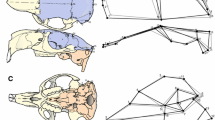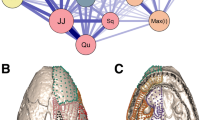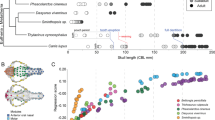Abstract
Mosaic evolution describes different rates of evolutionary change in different body units. Morphologically these units are described by more relationships within a unit than between different units which relates mosaic evolution with morphological integration and modularity. Recent evidence suggests mosaic evolution at the human basicranium due to different evolutionary rates of midline and lateral cranial base morphology but this hypothesis has not yet been addressed explicitly. We this hypothesis and explore how mosaic evolution relates to modular development. Evolutionary data sets on midline (N = 186) and lateral (N = 86) basicranial morphology are compared with 3D data on pre- and postnatal basicranial ontogeny (N = 71). Our results support the hypothesis of mosaic evolution and suggest a modular nature of basicranial development. Different embryological basicranial units likely became differently modified during evolution, with relatively stable midline elements and more variable lateral elements. In addition, developmental data suggests that modularity patterns change throughout ontogeny. During prenatal ontogeny lateral basicranial elements (greater sphenoid wings and petrosal pyramids) change together compared with the midline base. Close to birth the greater sphenoid wings keep a spatially stable position, while the petrosal pyramids become dissociated and shifted posteriorly. After birth the greater sphenoid wings and petrosal pyramids change again jointly and with respect to midline cranial base elements. This sequential pattern of integration and modularization and re-integration describes human basicranial ontogeny in a way that is potentially important for the understanding of evolutionary change. Phylogenetic modifications of this pattern during morphogenesis, growth, and development may underlie the mosaic evolution of the hominin basicranium.







Similar content being viewed by others
References
Ackermann, R. (2005). Ontogenetic integration of the hominoid face. Journal of Human Evolution, 48(2), 175–197. doi:10.1016/j.jhevol.2004.11.001.
Ackermann, R. R., & Cheverud, J. M. (2000). Phenotypic covariance structure in tamarins (genus Saguinus): A comparison of variation patterns using matrix correlation and common principal component analysis. American Journal of Physical Anthropology, 111(4), 489–501. doi:10.1002/(SICI)1096-8644(200004)111:4<489::AID-AJPA5>3.0.CO;2-U.
Baba, H., Aziz, F., Kaifu, Y., Suwa, G., Kono, R. T., & Jacob, T. (2003). Homo erectus Calvarium from the Pleistocene of Java. Science, 299(5611), 1384–1388. doi:10.1126/science.1081676.
Bach-Petersen, S., & Kjaer, I. (1993). Ossification of lateral components in the human prenatal cranial base. Journal of Craniofacial Genetics and Developmental Biology, 13, 76–82.
Bach-Petersen, S., Kjaer, I., & Fischer-Hansen, B. (1994). Prenatal development of the human osseous temporomandibular region. Journal of Craniofacial Genetics and Developmental Biology, 14(3), 135–143.
Bach-Petersen, S., Solow, B., Fischer-Hansen, B., & Kjaer, I. (1995). Growth in the lateral part of the human skull during the second trimester. Journal of Craniofacial Genetics and Developmental Biology, 15, 205–211.
Bastir, M. (2008). A systems-model for the morphological analysis of integration and modularity in human craniofacial evolution. Journal of Anthropological Sciences, 86 (in press).
Bastir, M., O’Higgins, P., & Rosas, A. (2007). Facial ontogeny in Neanderthals and modern humans. Proceedings of the Royal Society B: Biological Sciences, 274, 1125–1132.
Bastir, M., & Rosas, A. (2004). Comparative ontogeny in humans and chimpanzees: Similarities, differences and paradoxes in postnatal growth and development of the skull. Annals of Anatomy, 186(5–6), 503–509. doi:10.1016/S0940-9602(04)80096-7.
Bastir, M., & Rosas, A. (2005). The hierarchical nature of morphological integration and modularity in the human posterior face. American Journal of Physical Anthropology, 128(1), 26–34. doi:10.1002/ajpa.20191.
Bastir, M., & Rosas, A. (2006). Correlated variation between the lateral basicranium and the face: A geometric morphometric study in different human groups. Archives of Oral Biology, 51(9), 814–824. doi:10.1016/j.archoralbio.2006.03.009.
Bastir, M., & Rosas, A. (2008). Mosaic evolution, integration and modularity: Evolution of the human cranial base. American Journal of Physical Anthropology, S46, 65.
Bastir, M., Rosas, A., & Kuroe, K. (2004). Petrosal orientation and mandibular ramus breadth: Evidence of a developmental integrated petroso-mandibular unit. American Journal of Physical Anthropology, 123(4), 340–350. doi:10.1002/ajpa.10313.
Bastir, M., Rosas, A., Lieberman, D. E., & O’Higgins, P. (2008). Middle cranial fossa anatomy and the origins of modern humans. The Anatomical Record, 291(2), 130–140. doi:10.1002/ar.20636.
Bastir, M., Rosas, A., & O’Higgins, P. (2006). Craniofacial levels and the morphological maturation of the human skull. Journal of Anatomy, 209(5), 637–654. doi:10.1111/j.1469-7580.2006.00644.x.
Bastir, M., Rosas, A., & Sheets, D. H. (2005). The morphological integration of the hominoid skull: A Partial Least Squares and PC analysis with morphogenetic implications for European Mid-Pleistocene mandibles. In D. Slice (Ed.), Modern morphometrics in physical anthropology (pp. 265–284). New York: Kluwer Academic/Plenum Publishers.
Biegert, J. (1957). Der Formwandel des Primatenschädels und seine Beziehungen zur ontogenetischen Entwicklung und den phylogenetischen Spezialisationen der Kopforgane. Gegenbaurs Morphologisches Jahrbuch, 98, 77–199.
Biegert, J. (1963). The evaluation of characteristics of the skull, hands and feet for primate taxonomy. In S. L. Washburn (Ed.), Classification and human evolution (pp. 116–145). Chicago: Aldine.
Bookstein, F. L. (1991). Morphometric tools for landmark data. Cambridge: Cambridge University Press.
Bookstein, F. L., Gunz, P., Mitteroecker, P., Prossinger, H., Schaefer, K., & Seidler, H. (2003). Cranial integration in Homo: Singular warps analysis of the midsagittal plane in ontogeny and evolution. Journal of Human Evolution, 44(2), 167–187. doi:10.1016/S0047-2484(02)00201-4.
Bruner, E. (2004). Geometric morphometrics and paleoneurology: Brain shape evolution in the genus Homo. Journal of Human Evolution, 47(5), 279–303. doi:10.1016/j.jhevol.2004.03.009.
Bruner, E., Manzi, G., & Arsuaga, J.-L. (2003). Encephalization and allometric trajectories in the genus Homo. Evidence from the Neandertal and modern lineages. Proceedings of the National Academy of Sciences of the United States of America, 100(26), 15335–15340. doi:10.1073/pnas.2536671100.
Bruner, E., & Ripani, M. (2008). A quantitative and descriptive approach to morphological variation of the endocranial base in modern humans. American Journal of Physical Anthropology, 137(1), 30–40. doi:10.1002/ajpa.20837.
Bulygina, E., Mitteroecker, P., & Aiello, L. (2006). Ontogeny of facial dimorphism and patterns of individual development within one human population. American Journal of Physical Anthropology, 131(3), 432–443. doi:10.1002/ajpa.20317.
Chernoff, B., & Magwene, P. M. (1999). Afterword. In E. C. Olson & P. L. Miller (Eds.), Morphological integration (pp. 319–353). Chicago: University of Chicago.
Cheverud, J. M. (1982). Phenotypic, genetic, and environmental morphological integration in the cranium. Evolution; International Journal of Organic Evolution, 36(3), 499–516. doi:10.2307/2408096.
Cheverud, J. M. (1995). Morphological integration in the saddle-backed tamarin (Saguinis fuscicollis). American Naturalist, 145(4), 63–89. doi:10.1086/285728.
Cheverud, J. M. (1996). Developmental integration and the evolution of pleiotropy. American Zoologist, 36, 44–50.
Cobb, S., & O’Higgins, P. (2004). Hominins do not share a common postnatal facial ontogenetic shape trajectory. Journal of Experimental Zoology. Part B. Molecular and Developmental Evolution, 302B(3), 302–321. doi:10.1002/jez.b.21005.
Dabelow, A. (1931). Über Korrelationen in der phylogenetischen Entwicklung der Schädelform II. Die Beziehungen zwischen Gehirn und Schädelbasisform bei den Mammaliern. Gegenbaurs Morphologisches Jahrbuch, 67, 84–133.
Dean, M., & Wood, B. (2003). A digital radiographic atlas of great apes skull and dentition. In L. Bondioli & R. Macchiarelli (Eds.), Digital archives of human paleobiology. Milano: ADS Solutions.
Enlow, D. H. (1990). Facial growth. Philadelphia: W. B. Saunders Company.
Ford, E. H. R. (1958). Growth of the human cranial base. American Journal of Orthodontics, 44(7), 498–506. doi:10.1016/0002-9416(58)90082-4.
Goodrich, J. T. (2005). Skull base growth in craniosynostosis. Child’s Nervous System, 21(10), 871–879. doi:10.1007/s00381-004-1113-1.
Gould, S. J. (1977). Ontogeny and phylogeny. Cambridge, Massachusetts, London, England: Harvard University Press.
Hofer, H. (1952). Der Gestaltwandel des Schädels der Säugetiere und der Vögel, mit besonderer Berücksichtigung der Knickungstypen und der Schädelbasis. Verhandlungen der Anatomischen Gesellschaft, 99, 102–126.
Holloway, R. (1981). Exploring the dorsal surface of hominoid brain endocasts by stereoplotter and discriminant analysis. Philosophical Transactions of the Royal Society of London. Series B, Biological Sciences, 292(1057), 155–166. doi:10.1098/rstb.1981.0024.
Holloway, R. (1995). Toward a synthetic theory of human brain evolution. In J. P. Changeaux & J. Chavaillon (Eds.), Origins of the human brain (pp. 42–54). Clarendon, Oxford: Clarendon Press.
Jeffery, N. (2002a). Differential regional brain growth and rotation of the prenatal human tentorium cerebelli. Journal of Anatomy, 200(2), 135–144. doi:10.1046/j.0021-8782.2001.00017.x.
Jeffery, N. (2002b). A high-resolution MRI study of linear growth of the human fetal skull base. Neuroradiology, 44(4), 358–366. doi:10.1007/s00234-001-0753-z.
Jeffery, N., & Spoor, F. (2002). Brain size and the human cranial base. American Journal of Physical Anthropology, 118, 324–340. doi:10.1002/ajpa.10040.
Klingenberg, C. P. (2005). Developmental constraints, modules, and evolvability. In B. Hallgrímsson & B. K. Hall (Eds.), Variation (pp. 219–247). San Diego: Academic Press.
Klingenberg, C. P., Mebus, K., & Auffray, J.-C. (2003). Developmental integration in a complex morphological structure: How distinct are the modules in the mouse mandible? Evolution & Development, 5(5), 522–531. doi:10.1046/j.1525-142X.2003.03057.x.
Kuroe, K., Rosas, A., & Molleson, T. (2004). Variation in the cranial base orientation and facial skeleton in dry skulls sampled from three major populations. European Journal of Orthodontics, 26(2), 201–207. doi:10.1093/ejo/26.2.201.
Larsen, W. J. (2001). Development of the head, the neck, the eyes and the ears. In L. S. Shermann, S. S. Potter, & W. J. Scott (Eds.), Human embryology. New York, Edinburgh, London, Philadelphia: Churchill Livingston.
Lieberman, D. E., Hallgrimsson, B., Liu, W., Parsons, T. E., & Jamniczky, H. A. (2008). Spatial packing, cranial base angulation, and craniofacial shape variation in the mammalian skull: Testing a new model using mice. Journal of Anatomy, 212(6), 720–735. doi:10.1111/j.1469-7580.2008.00900.x.
Lieberman, D. E., McBratney, B. M., & Krovitz, G. (2002). The evolution and development of cranial form in Homo sapiens. Proceedings of the National Academy of Sciences of the United States of America, 99(3), 1134–1139. doi:10.1073/pnas.022440799.
Lieberman, D. E., & McCarthy, R. C. (1999). The ontogeny of cranial base angulation in humans and chimpanzees and its implication for reconstructing pharyngeal dimensions. Journal of Human Evolution, 36, 487–517. doi:10.1006/jhev.1998.0287.
Lieberman, D. E., Ross, C., & Ravosa, M. J. (2000). The primate cranial base: Ontogeny, function, and integration. Yearbook of Physical Anthropology, 43, 117–169. doi:10.1002/1096-8644(2000)43:31+<117::AID-AJPA5>3.3.CO;2-9.
Marroig, G., Vivo, M., & Cheverud, J. M. (2004). Cranial evolution in sakis (Pithecia, Platyrrhini) II: Evolutionary processes and morphological integration. Journal of Evolutionary Biology, 17(1), 144–155. doi:10.1046/j.1420-9101.2003.00653.x.
Mitteroecker, P., & Bookstein, F. (2007). The conceptual and statistical relationship between modularity and morphological integration. Systematic Biology, 56(5), 818–836. doi:10.1080/10635150701648029.
Mitteroecker, P., & Bookstein, F. (2008). The evolutionary role of modularity and integration in the hominoid cranium. Evolution; International Journal of Organic Evolution, 62(4), 943–958. doi:10.1111/j.1558-5646.2008.00321.x.
Mitteroecker, P., Gunz, P., Bernhard, M., Schaefer, K., & Bookstein, F. L. (2004). Comparison of cranial ontogenetic trajectories among great apes and humans. Journal of Human Evolution, 46(6), 679–698. doi:10.1016/j.jhevol.2004.03.006.
Mitteroecker, P., Gunz, P., & Bookstein, F. L. (2005). Heterochrony and geometric morphometrics: A comparison of cranial growth in Pan paniscus versus Pan troglodytes. Evolution & Development, 7(3), 244–258. doi:10.1111/j.1525-142X.2005.05027.x.
Morimoto, N., Ogihara, N., Katayama, K., & Shiota, K. (2008). Three-dimensional ontogenetic shape changes in the human cranium during the fetal period. Journal of Anatomy, 212(5), 627–635. doi:10.1111/j.1469-7580.2008.00884.x.
Nemzek, W. R., Brodie, H. A., Hecht, S. T., Chong, B. W., Babcook, C. J., & Seibert, J. A. (2000). MR, CT, and plain film imaging of the developing skull base in fetal specimens. AJNR. American Journal of Neuroradiology, 21(9), 1699–1706.
O’Higgins, P. (2000). The study of morphological variation in the hominid fossil record: Biology, landmarks and geometry. Journal of Anatomy, 197, 103–120. doi:10.1046/j.1469-7580.2000.19710103.x.
O’Higgins, P., Bastir, M., & Kupczik, K. (2006). Shaping the human face. International Congress Series, 1296, 55–73. doi:10.1016/j.ics.2006.03.036.
O’Rahilly, R. G., & Gardner, E. (1972). The initial appearance of ossification in staged human embryos. The American Journal of Anatomy, 134, 291–308. doi:10.1002/aja.1001340303.
Olson, E. C., & Miller, R. L. (1958). Morphological integration. Chicago: The University of Chicago.
Peña, A. (2000). Development of human brain. Human Evolution, 15(1–2), 99–112. doi:10.1007/BF02436238.
Plavcan, J., & German, R. (1995). Quantitative evaluation of craniofacial growth in the third trimester human. The Cleft Palate-Craniofacial Journal, 32(5), 394–404. doi:10.1597/1545-1569(1995)032<0394:QEOCGI>2.3.CO;2.
Raff, R. A. (1996). The shape of life. Gene, development, and the evolution of animal form. Chicago and London: The University of Chicago Press.
Richtsmeier, J. T., Aldridge, K., DeLeon, V. B., Panchal, J., Kane, A. A., Marsh, J. L., et al. (2006). Phenotypic integration of neurocranium and brain. Journal of Experimental Zoology. Part B. Molecular and Developmental Evolution, 306(4), 360–378. doi:10.1002/jez.b.21092.
Riedl, R. (1975). Die Ordnung des Lebendigen. Systembedingungen der Evolution. Hamburg: Paul Parey Verlag.
Rightmire, G. (2004). Brain size and encephalization in early to Mid-Pleistocene Homo. American Journal of Physical Anthropology, 124(2), 109–123. doi:10.1002/ajpa.10346.
Rilling, J. K. (2006). Human and nonhuman primate brains: Are they allometrically scaled versions of the same design? Evolutionary anthropology: Issues. News Review (Melbourne), 15(2), 65–77.
Rilling, J. K., & Seligman, R. A. (2002). A quantitative morphometric comparative analysis of the primate temporal lobe. Journal of Human Evolution, 42(3), 1–29. doi:10.1006/jhev.2001.0544.
Rohlf, F. J., Loy, A., & Corti, M. (1996). Morphometric analysis of old world Talpidae (Mammalia, Insectivora) using partial warp scores. Systematic Biology, 45(3), 344–362. doi:10.2307/2413569.
Rohlf, F. J., & Slice, D. (1990). Extensions of the procrustes method for the optimal superimposition of landmarks. Systematic Zoology, 39(1), 40–59. doi:10.2307/2992207.
Rosas, A., & Bastir, M. (2004). Geometric morphometric analysis of allometric variation in the mandibular morphology from the hominids of Atapuerca, Sima de los Huesos Site. The Anatomical Record Part A, 278A, 551–560. doi:10.1002/ar.a.20049.
Rosas, A., Bastir, M., Alorcón, J. A., & Kuroe, K. (2008). Thin-plate spline analysis of the cranial base in African, Asian and European populations and its relationship with different malocclusions. Archives of Oral Biology, 53(9), 826–834.
Ross, C., & Henneberg, M. (1995). Basicranial flexion, relative brain size, and facial kyphosis in Homo sapiens and some fossil hominids. American Journal of Physical Anthropology, 98, 575–593. doi:10.1002/ajpa.1330980413.
Ross, C. F., Henneberg, M., Ravosa, M. J., & Richard, S. (2004). Curvilinear, geometric and phylogenetic modeling of basicranial flexion: Is it adaptive, is it constrained? Journal of Human Evolution, 46(2), 185–213. doi:10.1016/j.jhevol.2003.11.001.
Ross, C. F., & Ravosa, M. J. (1993). Basicranial flexion, relative brain size, and facial kyphosis in nonhuman primates. American Journal of Physical Anthropology, 91, 305–324. doi:10.1002/ajpa.1330910306.
Ruff, C. B., Trinkaus, E., & Holliday, T. W. (1997). Body mass and encephalization in Pleistocene Homo. Nature, 387(6629), 173–176. doi:10.1038/387173a0.
Sgouros, S., Natarajan, K., Hockley, A., Goldin, J. H., & Wake, M. (1999). Skull base growth in childhood. Pediatric Neurosurgery, 31, 259–268. doi:10.1159/000028873.
Slice, D. E. (1998). Morpheus et al.: Software for morphometric research. Revision 01-01-00. Version evision 01-01-00. New York: Department of Ecology and Evolution, State University, Stony Brook.
Sperber, G. H. (1989). Craniofacial embryology. London, Boston, Singapore, Sydney, Toronto, Wellington: Wright.
Spoor, F. (1997). Basicranial architecture and relative brain size of Sts5 (Australopithecus africanus) and other Plio-Pleistocene hominids. South African Journal of Science, 93, 182–186.
Spoor, F., O’Higgins, P., Dean, C., & Lieberman, D. E. (1999). Anterior sphenoid in modern humans. Nature, 397, 572. doi:10.1038/17505.
Stringer, C. (2001). Modern human origins: Progress and prospects. Philosophical Transactions of the Royal Society of London. Series B, Biological Sciences, 357, 563–579. doi:10.1098/rstb.2001.1057.
Virchow, R. (1857). Untersuchung über die Entwicklung des Schädelgrundes im gesunden und krankhaften Zustande und über den Einfluß derselben auf Schädelform, Gesichtsbildung und Gehirnbau. Berlin: Reimer, G.
von Dassow, G., & Munro, E. (1999). Modularity in animal development and evolution: Elements of a conceptual framework for EvoDevo. The Journal of Experimental Zoology, 285, 307–325. doi:10.1002/(SICI)1097-010X(19991215)285:4<307::AID-JEZ2>3.0.CO;2-V.
Wagner, G. (1996). Homologues, natural kinds and the evolution of modularity. American Zoologist, 36, 36–43.
Wagner, G. P. (1990). A comparative study if morphological integration in Apis mellifera (Insecta, Hymenoptera). Zeitschrift für Systematik und Evolutionsforschung, 28, 48–61.
Wagner, G. P., & Altenberg, L. (1996). Complex adaptation and the evolution of evolvability. Evolution; International Journal of Organic Evolution, 50(3), 967–976. doi:10.2307/2410639.
Weidenreich, F. (1941). The brain and its role in the phylogenetic transformation of the human skull. Transactions of the American Philosophical Society, 31, 321–442. doi:10.2307/1005610.
Winther, R. (2001). Varieties of modules: Kinds, levels, origins, and behaviors. Journal of experimental Zoology (Mol Dev Evol), 291, 116–129.
Zelditch, M. L. (1987). Evaluating models of developmental integration in the laboratory rat using confirmatory factor analysis. Systematic Zoology, 36(4), 368–380. doi:10.2307/2413401.
Zelditch, M. L., Swiderski, D. L., Sheets, H. D., & Fink, W. L. (2004). Geometric morphometrics for biologists: A primer. San Diego: Elsevier Academic Press.
Zumpano, M. P., & Richtsmeier, J. T. (2003). Growth-related shape changes in the fetal craniofacial complex of humans (Homo sapiens) and pigtailed macaques (Macaca nemestrina): A 3D-CT comparative analysis. American Journal of Physical Anthropology, 120(4), 339–351. doi:10.1002/ajpa.10125.
Acknowledgements
We thank Emma Mbua, Fred Spoor, Roberto Macchiarelli, Luca Bondioli, Chris Stringer, Rob Kruszynski, Gerhard Weber, Paul O’Higgins, Tom Schoenemann and Janet Monge, (ORSA), Dan Lieberman, and the NESPOS society (www.nespos.org) for access to data in their care and Katie Willmore and Campell Rolian for inviting us to the interesting symposium at the AAPA meetings in Columbus, Ohio. We thank two anonymous reviewers for their helpful comments on a previous version. This research is funded by projects CGL-2006-02131 (Spanish Ministry of Science) and MRTN-CT-2005-019564-EVAN (European Union).
Author information
Authors and Affiliations
Corresponding author
Rights and permissions
About this article
Cite this article
Bastir, M., Rosas, A. Mosaic Evolution of the Basicranium in Homo and its Relation to Modular Development. Evol Biol 36, 57–70 (2009). https://doi.org/10.1007/s11692-008-9037-4
Received:
Accepted:
Published:
Issue Date:
DOI: https://doi.org/10.1007/s11692-008-9037-4




